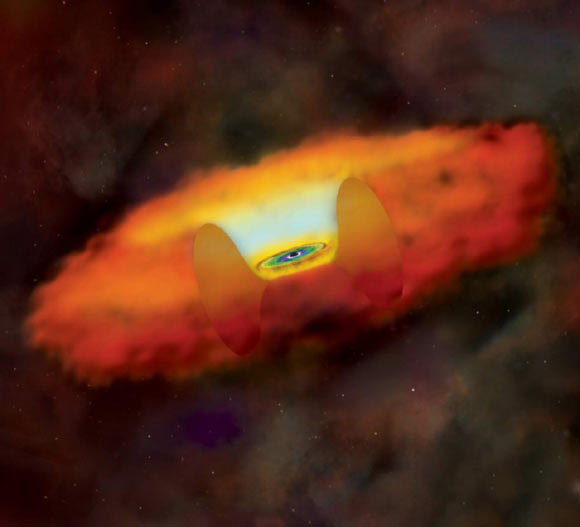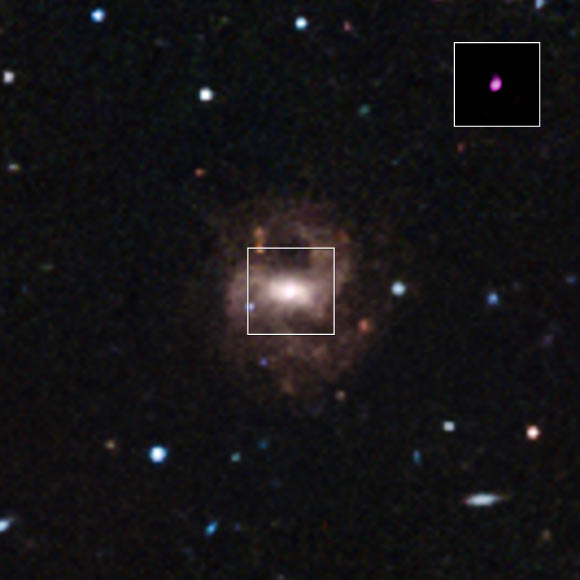A team of astronomers using NASA’s Chandra X-ray Observatory and the 6.5-m Clay Telescope in Chile has found the smallest supermassive black hole ever observed in the center of a galaxy.

An artist’s conception shows a supermassive black hole at the center of the dwarf disk galaxy RGG 118. Image credit: NASA / CXC / M.Weiss.
The supermassive black hole in question resides about 340 million light-years away at the center of a dwarf disk galaxy called RGG 118.
The estimated mass of this object is about 50,000 solar masses. This is less than half the mass of the previous smallest black hole at the center of a galaxy.
The black hole is nearly 100 times less massive than the supermassive black hole found in the center of the Milky Way. It’s also about 200,000 times less massive than the heaviest black holes found in the centers of other galaxies.
“It might sound contradictory, but finding such a small, large black hole is very important. We can use observations of the lightest supermassive black holes to better understand how black holes of different sizes grow,” said Dr Vivienne Baldassare from the University of Michigan, lead author of a paper accepted for publication in the Astrophysical Journal Letters (arXiv.org preprint).
“In a sense, it’s a teeny supermassive black hole,” said co-author Dr Elena Gallo, also from the University of Michigan.
The scientists figured out the mass of the black hole in RGG 118 by studying the motion of the gas near the center of the galaxy using visible light data from the Magellan Echellette Spectrograph on the Clay Telescope.
They then used the data gathered by the Chandra X-ray Observatory to figure out the brightness of material around the black hole in the X-ray band.
The X-ray luminosity tells scientists the rate at which the black hole is taking in matter. RGG 118 is consuming material at 1% the maximum rate, which matches the properties of other supermassive black holes.
“This little supermassive black hole behaves very much like its bigger, and in some cases much bigger, cousins. This tells us black holes grow in a similar way no matter what their size,” said co-author Dr Amy Reines, also from the University of Michigan.

A SDSS image of the dwarf disk galaxy RGG 118. The image is 3.2 arcmin across (about 317,000 light-years). The inset is a Chandra image showing hot gas around the black hole. Image credit: X-ray – NASA / CXC / University of Michigan / V.F.Baldassare et al.; optical – SDSS.
Scientists are trying to understand the formation of giant black holes from less than a billion years after the Big Bang, but many are undetectable with current technology.
They think supermassive black holes may form when a massive cloud of gas, with 10,000 to 100,000 solar masses, collapses into a black hole. Many of these black hole seeds then merge to form much larger supermassive black holes.
Alternately, a supermassive black hole seed could come from a massive star, about 100 times the Sun’s mass, that ultimately forms into a black hole after it runs out of fuel and collapses.
“We have two main ideas for how these supermassive black holes are born. This black hole in RGG 118 is serving as a proxy for those in the very early Universe and ultimately may help us decide which of the two is right,” Dr Gallo said.
The astronomers will continue to look for other supermassive black holes that are comparable in size or even smaller than the one in RGG 118 to help decide which of the models is more accurate and refine their understanding of how these objects grow.
_____
Vivienne Baldassare et al. 2015. A ~50,000 solar mass black hole in the nucleus of RGG 118. ApJL, accepted for publication; arXiv: 1506.07531







